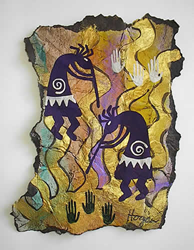T here are many myths and legends surrounding the Kokopelli figure. He is found in rock art as early as 200 AD and as late as the 16th Century. In nearly every depiction Kokopelli is hunchbacked, plays a flute and sports an exaggerated phallus.
 In some myths Kokopelli is portrayed as a "traveling
salesman"
going from village to village, playing the flute to let
people know he is here. His hunchback is a pack full of
blankets and other wares for sale.
In some myths Kokopelli is portrayed as a "traveling
salesman"
going from village to village, playing the flute to let
people know he is here. His hunchback is a pack full of
blankets and other wares for sale.
Other stories say his pack is full of seeds and he plays the flute to help the seeds to grow. Traditional Hopis used to play flutes in the cornfields to get the corn to grow. This could be a part of why Kokopelli is seen as a fertility symbol.
Of course the exaggerated phallus plays into this interpretation as well! Kokopelli was seen by some to be a rascal ready to chase and impregnate the young girls of the village.
John V. Young, in his book Kokopelli: Casanova Of The Cliff Dwellers , writes that the name Kokopelli may derive from Zuni and Hopi names for a god (Koko) and a desert fly they call "pelli." Apparently the fly has a hump on his back and the flute could be the insect's long proboscis. In many drawings Kokopelli does look like an insect with "feelers" on his head. Although another interpretation of the "feelers" could be wearing from one to five feathers.
All in all, Kokopelli is a happy figure, a traveler, a fertility spirit, a god of mirth and music ready to plant a seed, swap a song and steal your heart away.
Read more about Rock Art symbols.
![]()
